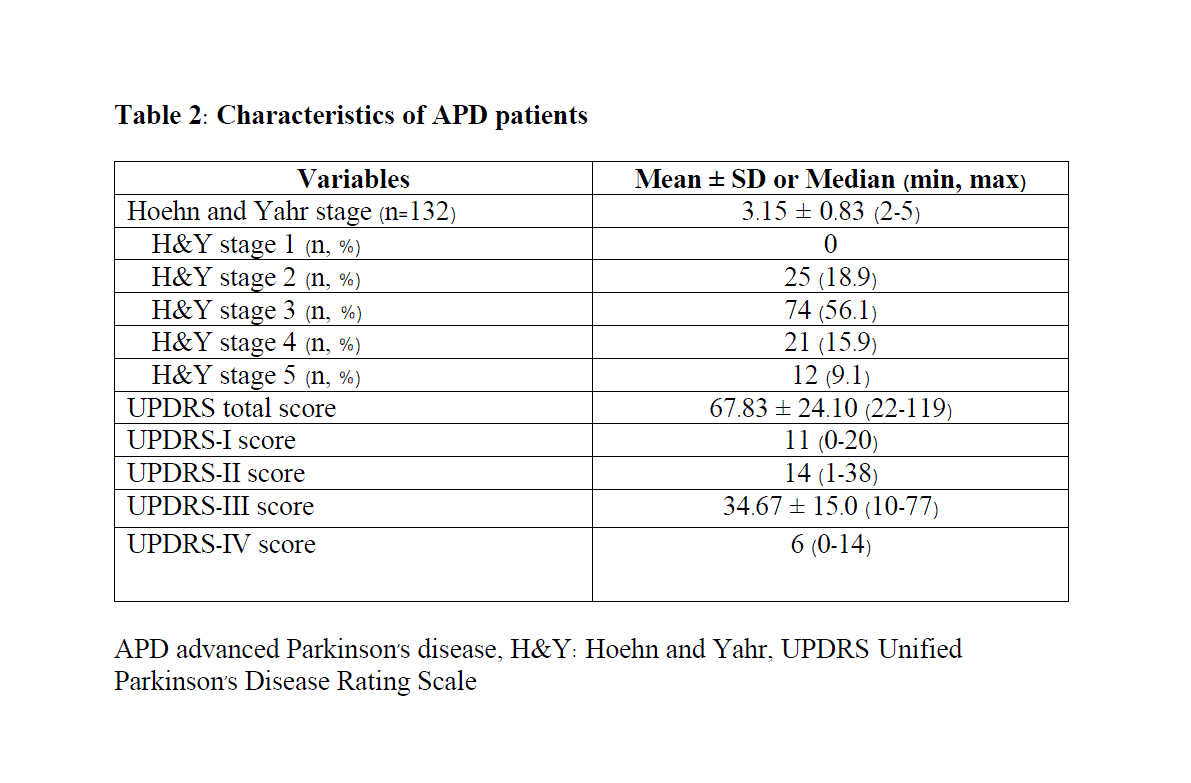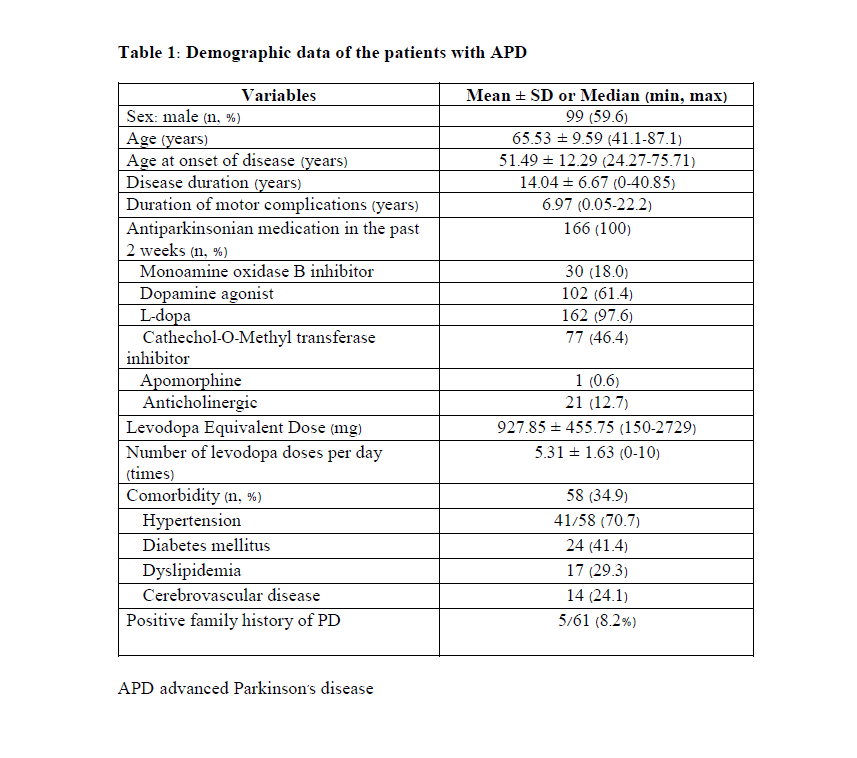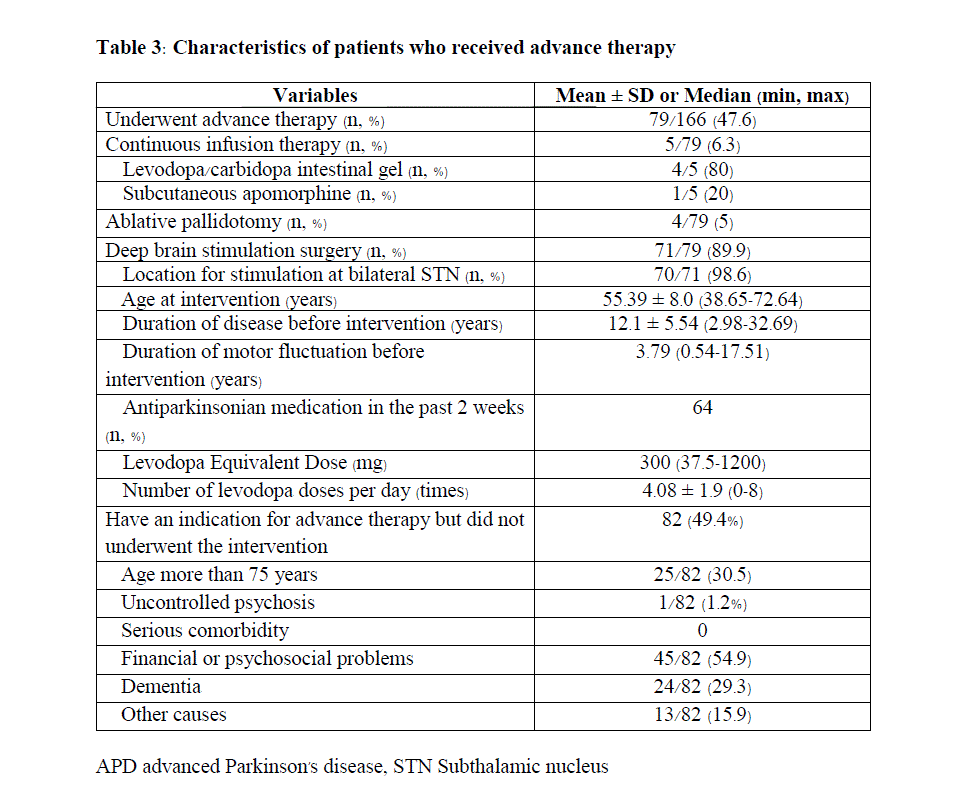Session Information
Date: Tuesday, September 24, 2019
Session Title: Parkinsonisms and Parkinson-Plus
Session Time: 1:45pm-3:15pm
Location: Agora 3 West, Level 3
Objective: To identify the prevalence of APD in Thai PD patients who were registered to Movement disorders clinic at Siriraj Hospital, Thailand. The demographic data and modalities of treatment including oral and advanced non-oral therapies were also collected.
Background: Parkinson’s disease (PD) is divided into 3 stages including early, mid, and advanced stage. However, the border zone between each stage is not clear [1]. Identifying the stage of the disease is clinically important because management of advanced PD (APD) is needed to integrate the knowledge and select the proper treatments for combatting motor, non-motor symptoms, and motor complications. Recently, there is the statement addressed the definition of APD published from the “Consensus on the Definition of Advance Parkinson’s disease (CEPA) study” [2]. The advantage of this consensus may help us to estimate the prevalence of APD and may guide the physicians to employ more suitable treatments to the APD patients.
Method: A retrospective chart review of all registered patients, total 452 patients, at our clinic from January 2016 to December 2018 was done with approval by the IRB. All data were collected during “ON” time.
Results: The prevalence of APD using CEPA’s definition was 36.7% (166 out of 452) with male predominance (59.6%). The mean age of APD was 65.53 ± 9.59 years. The mean of disease duration was 13.9 + 6.2 and median of motor complication duration was 6.97 years [table1]. The APD patients were mostly in H&Y stage 3 (56.1%). Mean score of total UPDRS was 67.83 ± 24.10 which mean score of UPDRS part III was 3.15 ± 0.83 [table2]. Seventy-nine patients (47.6%) received advanced non-oral therapies which mainly was an STN-DBS (89.9%). The most factor that prevents the APD from the advanced therapies was the financial and psychosocial problems (54.9%) [table3].
Conclusion: Prevalence of APD in our population was one-third. Less than half of APD could achieve the proper treatment for controlling their symptoms. This current results may rise of the awareness of identifying APD and make an impact to the level of the policy to provide proper care which APD patients deserve.
References: 1. Hoehn MM, Yahr MD. Parkinsonism: onset, progression and mortality. Neurology. 1967;17(5):427-42. 2. Luquin MR, Kulisevsky J, Martinez-Martin P, Mir P, Tolosa ES. Consensus on the Definition of Advanced Parkinson’s Disease: A Neurologists-Based Delphi Study (CEPA Study). Parkinsons Dis. 2017;2017:4047392
To cite this abstract in AMA style:
J. Srikajon, P. Srivanitchapoom, Y. Pitakpatapee, A. Pisarnpong, T. Sangpeamsook, A. Suengtaworn. Prevalence of advanced Parkinson’s disease in Thai patients with Parkinson’s disease using the Consensus on the Definition of Advance Parkinson’s disease (CEPA Study): A single-center study [abstract]. Mov Disord. 2019; 34 (suppl 2). https://www.mdsabstracts.org/abstract/prevalence-of-advanced-parkinsons-disease-in-thai-patients-with-parkinsons-disease-using-the-consensus-on-the-definition-of-advance-parkinsons-disease-cepa-study-a-single/. Accessed April 21, 2025.« Back to 2019 International Congress
MDS Abstracts - https://www.mdsabstracts.org/abstract/prevalence-of-advanced-parkinsons-disease-in-thai-patients-with-parkinsons-disease-using-the-consensus-on-the-definition-of-advance-parkinsons-disease-cepa-study-a-single/



